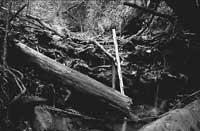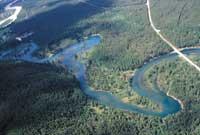Dead wood, living river
2008/04/01 Aristegi Urkia, Lide - Biologoa Iturria: Elhuyar aldizkaria

The wood can reach the riverbed in many different forms: in snowfalls and ventures, due to the erosion of the slopes of the margins or the fall of trees already planted. The importance of each of these processes depends on its location and the type of riparian forest; for example, in the escarpments of the rivers the landslides introduce a lot of wood; in the plains, the migrations of the meanders. Once the wood falls into the water, it can be retained or the river can carry it down. The trunks usually form stable wooden dams in small races, while in the large ones are more mobile batteries.
Wood shapes the shape of the riverbed into wells and waterfalls. These wells provide cover and protection to fish and invertebrates, curbing water and sediments. Trout are put into gravel that accumulate in slow water. In addition to the sediments accumulate the litter, an important energy source of the forage network.
Importance of wood from streams
Retains water, organic matter and sediments: Wood is the most retaining structure of the riverbed, since 75% of organic matter accumulates in wood, that is, most of the fodder that the river will receive throughout the year. Wood hinders water, decreasing speed and increasing retention capacity. The force of water in floods means that a lot of food and sediments are transported and that the function of wood is essential at that time.
Stabilizes riverbed and banks: Due to its influence on sediment transport, wood stabilizes the riverbed, it can be said that it is the "backbone" of the river. The presence of wood prevents erosion of both channels and margins in small and large streams.

It offers important habitats: large trunks protect fish from flooding and predators, creating shade, pastures, setting and growing places. They help in the migration of adult fish, forming calm waters for rest. In harsh droughts, deep ponds offer shelter to fish.
Offers food: Several bacteria, fungi and microorganisms grow in dead wood. Offers Invertebrate Food: Several bacteria, fungi and microorganisms grow in dead woods. Some species of invertebrates eat wood.
Maintains the life cycles of invertebrates: The life cycle of several invertebrate species is closely linked to wood. As larvae live in water and adults on land, it helps them to expel them from water.
It is an important refuge: Most aquatic animals of all groups (invertebrates, fish, amphibians, birds and mammals) use wooden dams as shelter and viewpoint. During flood times, invertebrates are protected between gravel or after logs.
Improves water quality: The wood increases the retention capacity of the river and keeps the matter at rest longer. Thus, the living beings of the river use it as food and make it purify. Wood dams help water oxygenation.
It regulates the formation of islands: wood in large rivers is not able to form dams, but the sediments that remain around the trunks form islands.

Although wood has a great ecological importance in streams, it is still extracted from the channels for various reasons. For example, in some places wood can close bridges and cause flood damage. But the solution is not always wood extraction, as the right design bridges do not suffer damage. In some cases, wooden dams have been eliminated to facilitate the passage of fish, without taking into account that they are the most suitable prey to protect fish and that, in addition, they are rarely barriers to the migration of fish. For aesthetic reasons, to keep the river "clean" are often removed all wood structures, forgetting the ecological damage that this entails to the river.
Influence of education and development on wood perception
As we have seen, dead wood is very important for the ecological quality of rivers. However, in our society few people realize it. It is interesting to observe how the perception of dead wood changes from one place to another, which can significantly influence the recovery of rivers.
For example, a few years ago, a survey of university students was conducted in 10 countries. They showed photos of streams rich in wood and without wood and were asked for their opinion. In most countries, students preferred rivers without wood, which seemed more natural, beautiful and safe. In Oregon (USA) ), Germany and Sweden thought otherwise, in places with plenty of forests and in areas that begin to regenerate rivers. The perception of wood is therefore related to the socio-cultural development of society.
Societies are not, of course, homogeneous. The same survey was conducted in Poland for students in geography, biology and water engineering. Geography and biology students, especially in recent years, appreciated the dead wood of the streams, while engineers considered it very dangerous. There is much to learn from this type of research to reduce the negative impact of society on the environment.

Dead wood, river recovery tool
In recent years the role of dead wood in streams has become increasingly evident. But, at the same time, it is evident that in most rivers and streams of the world there is little wood, since for centuries it has been extracted from the channels. Therefore, several restoration projects have been carried out that have introduced dead wood into the river. Of course, it's not about blindly throwing the wood into the streams. It is necessary to analyze well why there is little wood in the channel, what ecological benefits can bring in each case and, of course, what economic or social damage can occur. The goal should be clear: increase the fish population, reduce erosion and increase adhesion. It is essential to analyze the steps and deadlines to meet this goal.
Examples of restoration projects that have returned wood to the river or stream are:
- In the United States, especially in the western states, they have recognized the role of wood and their exit from the channel is prohibited. In addition, logs enter the water to increase fish.
- New Forest is a plateau covered with English peatlands. 150 years ago they corrected and dragged the rivers, which endangered the turbine. At present, wood has been demolished in the channels to accumulate sediments and raise the level of groundwater for recovery.

Dead wood in the races of the Basque Country
Researchers from the University of the Basque Country have been researching the role of wood in rivers for years. The results show that the presence of wood in our races is scarce due to human activities (riverbed cleaning, alteration of the riparian forest), which makes the complexity and adhesion of many channels scarce. In a project carried out between 1995 and 1998, wood was extracted from the channels of some streams. The conclusions showed the importance of wood in the control of sediment erosion, the accumulation of organic matter and the formation of wells.
A recognised scientific study is currently underway at the European level. The European Union grants projects called LIFE to support Community environmental policy in collaboration with local entities. In the 2005 call, 182 projects were presented and 54 were approved. Among them, LIFE Aiako Harria was sixth. The project, promoted by the Diputación de Gipuzkoa and the municipalities of the Aiako Harria Natural Park, aims to improve the conservation status of rivers and species that inhabit them.
Aiako Harria Natural Park is an area of great natural value whose streams and rivers are one of the most powerful in the Basque Country. Inside the park is the Añarbe reservoir, which provides half of the Gipuzkoans with the highest quality water. However, not everything is good in the area and research has found two problems in the streams that lead to the Añarbe. On the one hand, the populations of the river species are not in very good condition, neither fish, nor threatened water moles or European minks. It is suspected that the river habitat is not well enough. Moreover, the Añarbe reservoir houses large amounts of sediments and stains, many tons annually, which can affect the quality of water in the long term.
In order to solve these two problems, the LIFE project will include wood in several streams that go to the reservoir. In this way, the capacity for adhesion and accumulation of organic matter is expected to increase, increasing the diversity of habitats and at the same time the biomass and diversity of organisms (algae, invertebrates, fish). At the functional level of the ecosystem, both the adhesion capacity of food and the efficiency in the use of organic matter will be greater and the river metabolism will be more active.

The wood will be deposited in the selected streams until the quantity of wood is available in the natural rivers. A year before and after the introduction of wood will determine changes in the morphology of the channel, granulometry, amount and distribution of sediment, hydraulic adhesion, adhesion of food and leaf litter, metabolism, decomposition of the litter and abundance and communities of periphytes, macroinvertebrates and fish. The initial follow-up has already been carried out and now the next step is to introduce the wood.
This project will allow to know the complexity of the channel and, above all, the importance of wood in the rivers, as well as its influence on both and on the functioning of the ecosystem. This will provide relevant information for future possible actions. The project includes researchers from the University of the Basque Country, with the help of technicians from some municipalities, the Government and the Provincial Council. This project aims to analyze the techniques of recovery of the most wild rivers, ensure the quality of the waters and increase the value of the natural park of Aiako Harria for the enjoyment of visitors both local and external.
Thanks to Arturo Elosegi and Joserra Díez for showing the step between woods and Leire Ruiz for making the way with me. And, of course, to Igor Aristegui for his last impulse.

Gai honi buruzko eduki gehiago
Elhuyarrek garatutako teknologia






